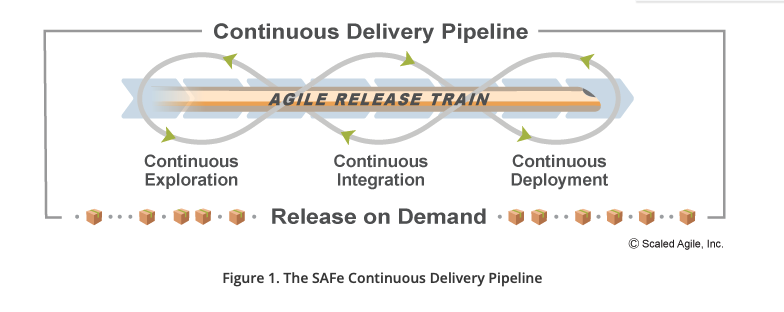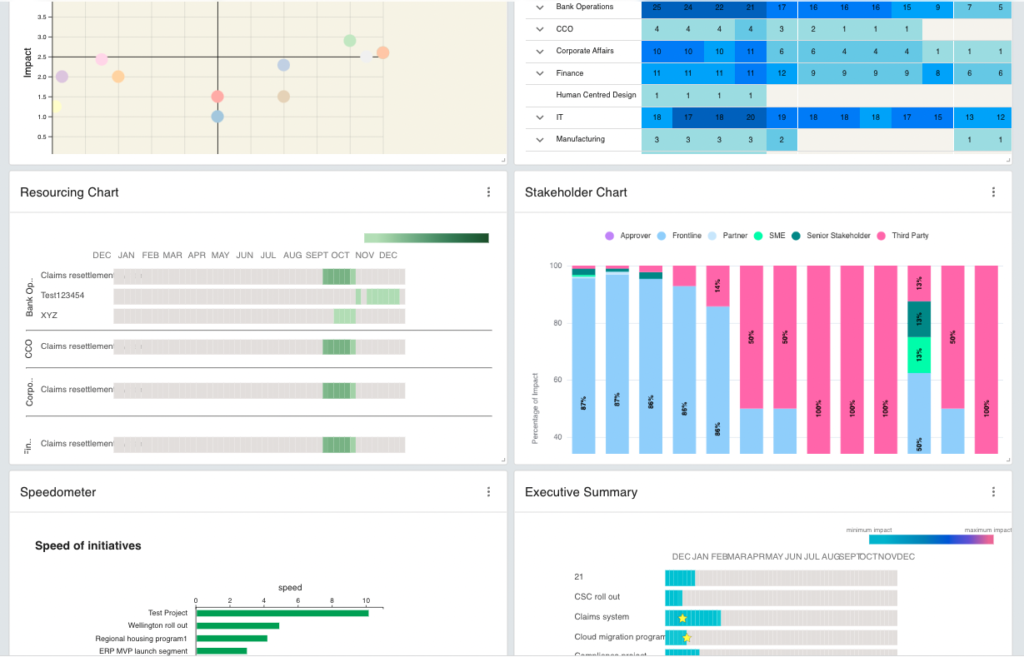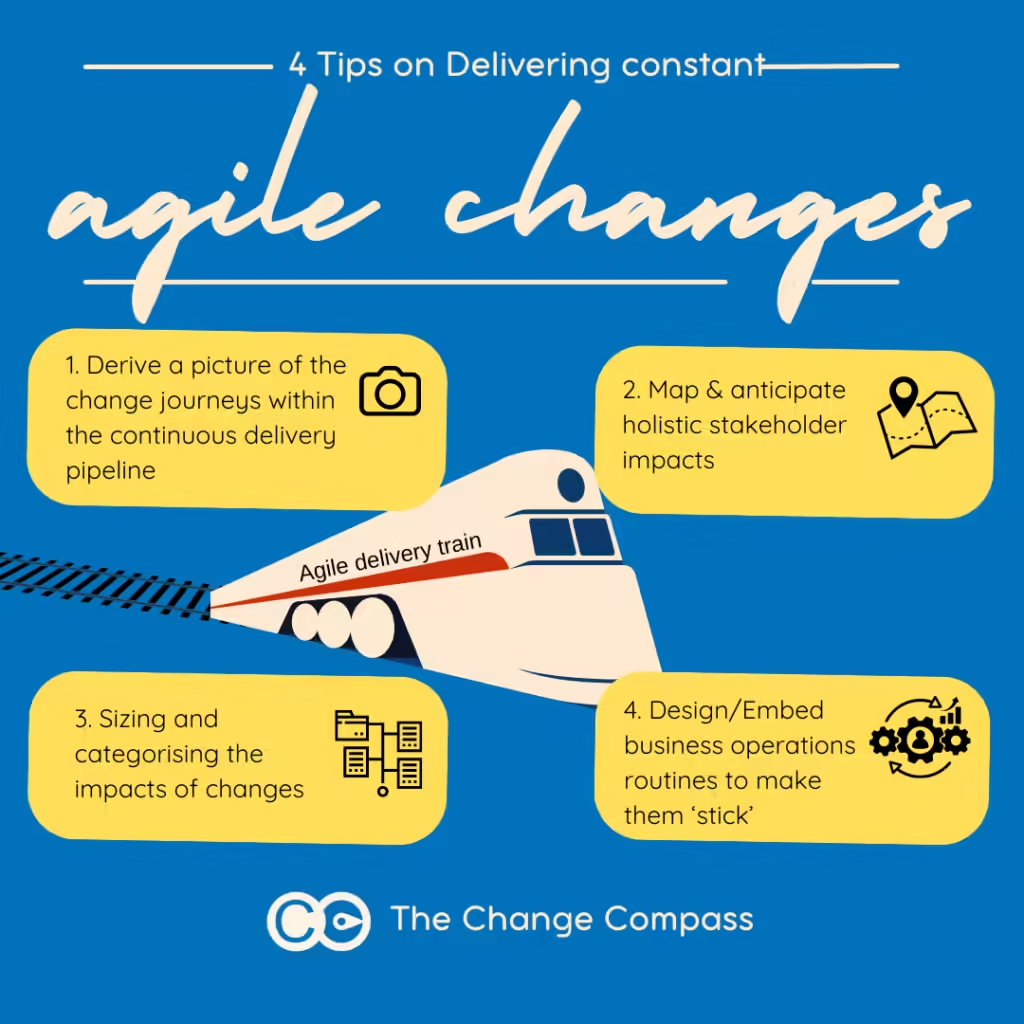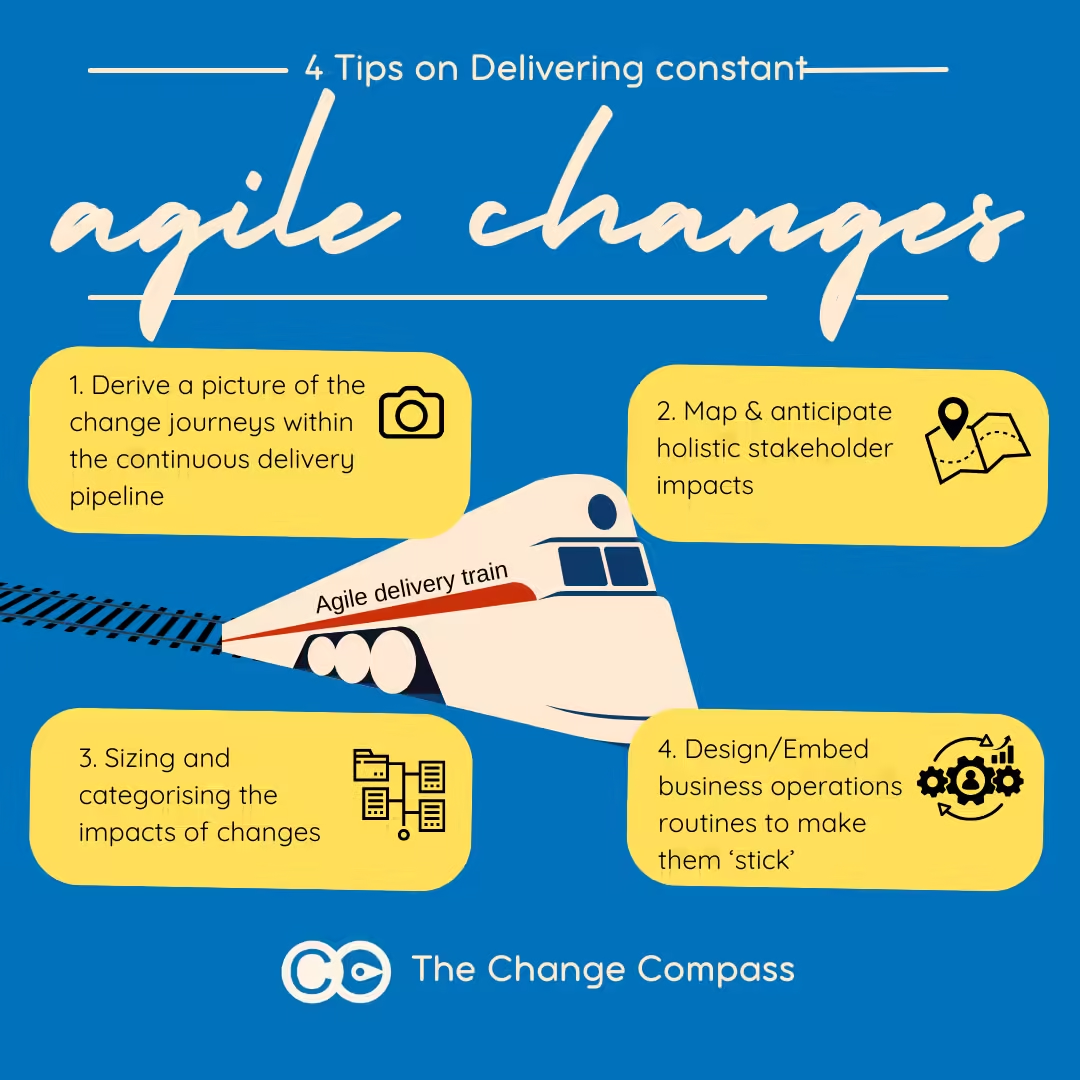Delivering constant changes is a requirement in implementing agile change management. With each iteration, a change is being designed and released as a part of ongoing agile development and project implementation. However, there is little mention in change management literature of how to go about delivering change constantly and be able to achieve optimum change adoption.
Continuous delivery pipeline
The concept of a ‘continuous delivery pipeline’ is a core part of the agile methodology. It refers to having a structured pipeline of continuous changes being released as required by the organisation. The pipeline contains a set of features and changes to be worked on, and the resulting prioritised changes are released when and as needed.
The three components of a continuous delivery pipeline that forms an agile release train include:
- Continuous exploration – This is about defining and scoping what needs to be built using human centred design approaches to design the problem that needs to be solved from the user perspective
- Continuous integration – This step involves taking those prioritised features from the backlog and investigating further to understand what development work is required to turn them into solutions for the user.
- Continuous deployment – This is about turning the completed changes from the staging environment into production, meaning the live product that is ready to be used by the user. After the technical part of the solution is ready to be released, the business then determines when is a good time for this release to go ahead.

The ‘technical side’ of the agile team is fairly well defined in terms of the roles and responsibilities of each member, including project manager, developer, QA/testing, business analyst, business owner, etc. However, the role of the change manager is much less defined and black and white. This does not mean that there is no role for the change manager though. It just means that the agile literature has not well defined the details for the role of the change manager in an agile team. ‘Agile change management’ still has some work to do to make itself better known to other agile team members.
So how does the change manager get ready to deliver a series of constant changes?
Delivering a series of constant changes is no easy feat. The main issue is that most businesses are not designed to face multiple changes, and nor are they designed to face a series of continual changes either.
Change approaches are primarily written for working on one change at a time, and not in a setting where there are continual releases of changes going on. On the other hand, how many organisations do you know that are only facing one change? Or that only deals with one change within a month? This type of stable change environment may have been the norm years ago when the business environment was much more predictable and stable. Hence, using a waterfall project approach was appropriate at the time. Fast-forwarding to the 2020s most organisations are juggling with constant and multiple changes as the norm.
1. Derive a picture of the changes within the continuous delivery pipeline.
Deriving a clear picture of what changes look like within a project is critical. Without this, you will not be able to clearly communicate to your stakeholders what changes are coming down the pipeline.
To create this picture, use a human-centred approach and illustrate what the user will go through throughout the change journey. This is similar to a user journey map. However, a change-focused picture goes beyond just what the user will be going through. It also includes not just person-based changes, but also process, policy, system, governance, reporting and other changes. Outlining these changes will complete the whole picture of what each change release may look like.
A key problem in creating a picture of the changes early on is that the project team may not even know what the solution looks like. And without particular details of every change release and solution design, it may be hard to create this picture.
The recommended approach is to focus on what the outcome could look like versus focusing on various technical or process solutions. This means you may even need to make particular assumptions in defining what these changes look like. For example:
Release 1: Ability to turn recorded customer conversations into text. With this feature, there will be new risk and privacy processes and governance be put in place in the monitoring and storage of customer data.
Release 2: Ability to search for customer conversation history and flag follow up actions required. Specialist roles may be required to audit customer conversation text. Behaviour shifts in proactively checking on customer history and knowing what to look for in trends is critical.
Release 3: Ability to use analytics to predict customer turnover and use this to minimise customer turnover. Significant capability uplift is required to ensure that consultants are able to know how to use analytics to help minimise customer turnover. Analytics capability uplift is also required at operations management, supervisor and team leader levels.
2. Map holistic stakeholder impacts.
In order to implement constant ongoing changes, it is critical to understand holistically what the stakeholders are undergoing across all types of changes and other BAU impacts. Without taking these into account it is not possible to truly understand the capacity of stakeholders and when changes will best ‘stick’ when released.
Some of the items that should be inventoried and mapped include:
- Impacts from the current project that you are working on
- Other project impacts that affect the stakeholder at the same time as your project, including any benefit realization periods post project implementation
- BAU-led initiatives that could include business improvement or quality, and may not classified as ‘funded projects’ per se
- Key high work volume periods such as end of financial year, holiday season, etc.
- Audits, planning or reviews where additional work volumes are forecasted
It does take investment and effort to collect all these types of data and most change managers do not bother to do this. However, it is not possible to implement a successful change when you do not understand what other changes or work priorities your stakeholders are undergoing during the change process.
It is also important to note that this type of impact data can change constantly and once the data is collected it needs to be verified on a timely basis with any changes and updates reflected over time. Doing this activity manually can be quite cumbersome so we advise using digital tools such as The Change Compass.
The collected data on what stakeholders are undergoing can be significantly valuable. Often stakeholders themselves have not undertaken this exercise to truly understand the change journeys and work priorities added together holistically. They may be surprised by the picture you are presenting to them. At the minimum, they will value this since it shows that you have a deep understanding of what they will be going through and therefore create more stakeholder confidence.

3. Sizing and categorising the impacts of changes
After getting a clear picture of holistic change environment that the stakeholders will be undergoing the next step is to analyse the impacts from your project. In analysing the change impacts you should be ascertaining the nature of these change impacts including:
- Size of the impact
- How long the impacts will last
- How much time these impacts translate to
- Types of these impacts (e.g. people, process, system, customer, etc.)
- To whom the impacts will be on
Quantitatively sizing your impacts makes them concrete and easily understood. Armed with this information you are able to examine to what extent the planned releases are the right ‘size’ for the impacted stakeholder groups. This is another critical part of agile change management. In determining this, the following stakeholder factors are critical:
- Capacity bandwidth
- Potential overlaps across various impacts either within the same or with other projects or initiatives
- Change maturity level and experience with similar changes in the past
- Leadership support and other change reinforcement mechanisms
- Overall change readiness
- Engagement level with the particular change initiative
When you have considered all of these factors you are ready to engage with your project manager, the PMO, and business representatives to assess to what extent the roadmap laid out is effective and will work to maximise the targeted initiative benefits.

4. Business operations routines
Now you understand clearly the change environment of your impacted stakeholders, various changes within yours’ and other initiatives, and the categories of the various change impacts. The next step is to clarify to what extent your impacted business units have the right operational process to receive ongoing changes. This is often a neglected part of agile change management.
More change mature business units have over time developed the right routines and processes to absorb changes, especially ongoing ones. What are some of these?
Effective engagement processes. Engagement processes are not just one-way communication channels. Having effective communications channels such as newsletters and town halls are a minimum for employees to hear about what is coming down the pipeline. Engagement processes include such as effectively choreographed Yammer channels, skip-level meetings (where managers meet with employees 2 levels down), focus group sessions with a small group of select employees, and effective team meetings where information is passed both up and down the chain of command
Effective learning processes. Effective learning processes at a business unit level includes business operations routines whereby employees have individual development plans (from which training plans can be incorporated), ongoing monitoring of development tracking against targets (e.g. completion rates), virtual learning processes (e.g. employee familiarity with virtual ways of self-initiated learning)
Change champion network. Most change champion networks are project-based and therefore have a limited shelf-life. This means that business change champions have a limited time to learn and develop as effective change champions. They also have limited time to practice and experience what it is like to lead and support change. A better design for business units undergoing ongoing changes is to have business unit based change champions that can support a myriad of changes across the board. This flexes their capability. Also, with constant exposure to changes over time, they are able to continuously develop and become better change champions. Organisations that have done this well, have positioned this as a ‘talent pool’ for frontline employees seeking to grow into other challenging roles.
Benefit realisation processes. Tracking and reinforcing benefit realisation is one of the most critical ingredients for success in the impacted business unit. Usually a month after go-live, the project would have already wrapped up and the business is left to continue the rest of the change journey and achieve the targeted benefits. To do this the business unit needs to have clear benefit realisation tracking and reinforcing mechanisms, involving Finance and business leaders. There needs to be constant oversight of how the benefit tracking is trending and leader discussions on resolving any obstacles and providing adequate managerial support to drive the benefit realisation process.
If your impacted business unit lacks one or more of these ingredients, it is critical that you work on this upfront. Highlight to business leaders the risk of not having these ingredients in place within the business. These processes may take significant time and investment to build up. Therefore, factor in the time required to develop these. Often, within the challenges of agile changes, these are left until the end, by which time it is too late to try and establish quickly to support the identified project changes.
To read more about agile changes visit our Agile Change Management section of our Knowledge Centre.
Also, check out our Agile Change Management Playbooks for practical know how in leading your project.






